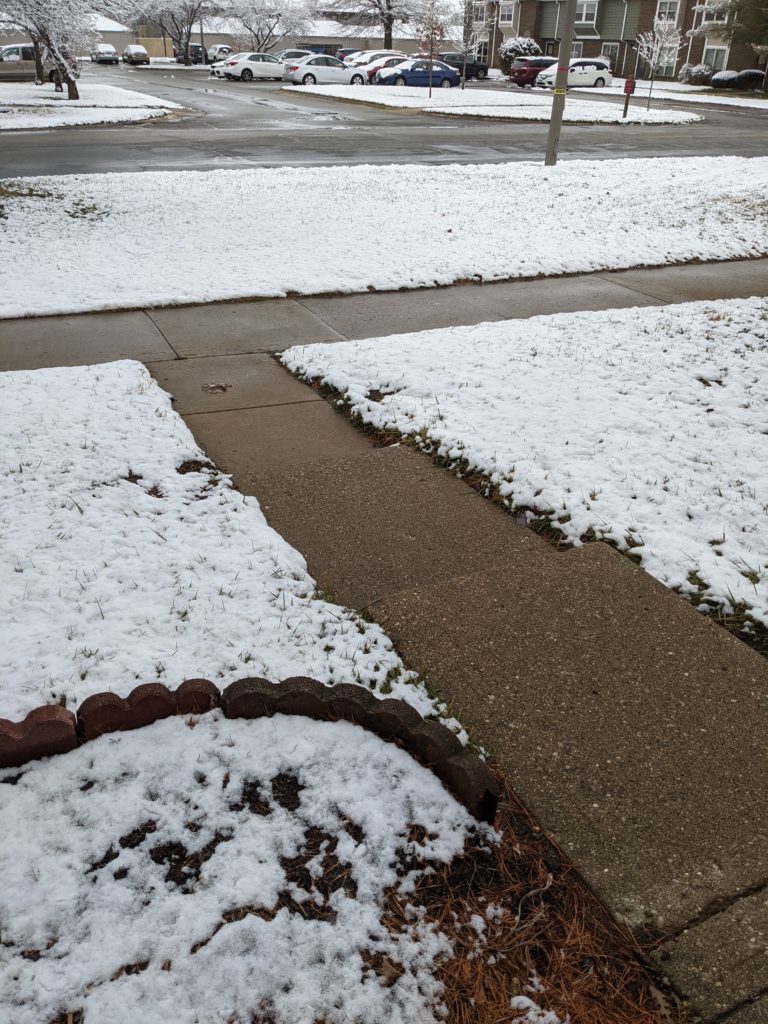
Daily gratitude: Today I’m grateful that the snow on the sidewalk melted before I had to shovel it.


Daily gratitude: Today I’m grateful that the snow on the sidewalk melted before I had to shovel it.
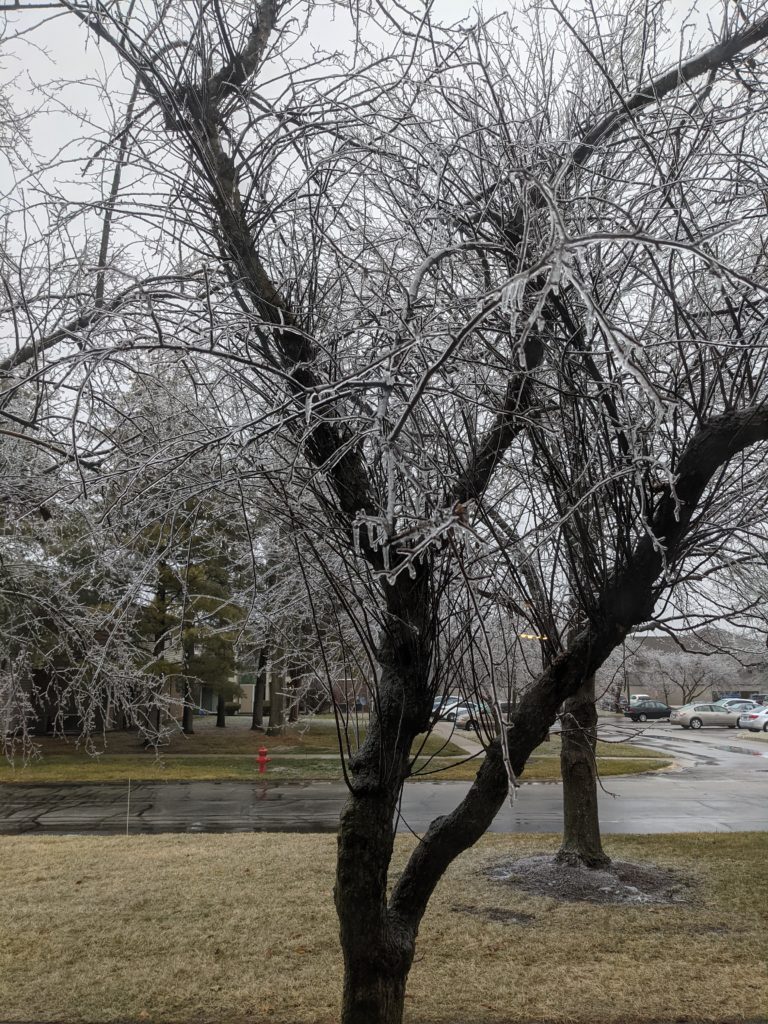
Pretty icy out there.
Five years ago made a plan to spend the winter trying to build the strength I thought I’d need in order to be successful at (and enjoy) training for parkour. To keep the whole thing manageable, I chose just four specific exercises to work on. And to keep myself accountable, I described a “success” condition to let me know if I had accomplished each one. (I documented my plan here: strength training specifically for parkour.)
I wasn’t successful at meeting most of those goals after that first winter, which was discouraging, and I kind of quit tracking my progress on those metrics after that. But in my preparations for writing my “Movement in 2020” post, I happened upon that post—and was surprised to see that I had pretty much accomplished it!
Squatting is an important transitional posture, into and out of ground movement, and into and out of jumps. (It’s also a basic human capability, but one that requires a degree of strength and flexibility that most westerners no longer have.)
Five years ago I could only just barely squat, and then only when nicely warmed up. Since then I have worked on my squat in a dozen different ways—working on ankle mobility, hip mobility, and strength up and down the posterior chain.
My original benchmark was:
Success will be when I can get all the way down with a straight back, and then use my hands to manipulate things that are nearby.
I can report a considerable degree of success! I can get down into a deep squat, and I can linger there for tens of seconds at a time. I’m now working on improving my mobility while in a squat (looking to each side, up and down, reaching up and down, etc.).
Here’s where I was back then, and where I am now:
Early on my efforts to get better at various natural movements were significantly hindered by a lack of toe flexibility. My toes literally did not bend back at all.
This was actually a long-standing problem. At least as far back as college my martial arts instructors warned that I needed to pull my toes back or I’d hurt myself if I executed the kicks I was learning. But none of my martial arts instructors had even the tiniest bit of advice on how I might acquire the capability to pull my toes back.
Five years ago I came up with my own idea. I’d get into quadruped position while keeping my weight back on the balls of my feet (meaning that my knees had to be rather higher than ideal), then I gently worked to lower my knees toward the floor. That helped me make some progress.
A couple of years later, Ashley Price suggested an excellent exercise involving using a half-dome to let me gently flex my toes back. I’ve been doing that exercise almost daily since then.
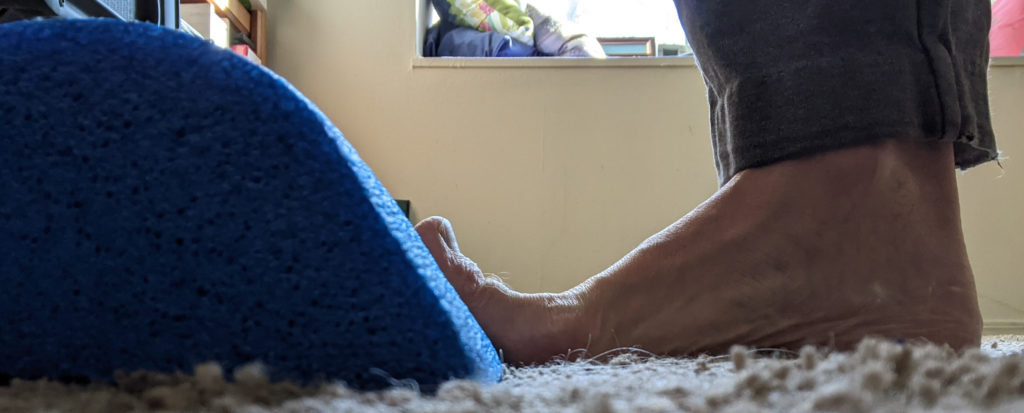
My original benchmark was:
Success will be when I can keep my weight back on the balls of my feet and still get into position for things like planks, push-ups, and lunges.
On that I can report complete success. The only thing that still eludes me is the quasi-martial arts move where you sit seiza (kneeling with the tops of your feet on the floor) then pull your toes back and tuck them under, shift your weight to the balls of your feet, rock back into a squat from which you can stand up. This is useful if you want to move from kneeling to standing while simultaneously drawing a sword, but is perhaps not particularly important beyond that.
The ability to hang by your hands is crucial for many parkour moves.
Hanging was one of the things I worked on early, and made quite a bit of progress at, working up to being able to hang for a minute no problem. At about the same time I briefly managed to do a chin-up. But until this year I hadn’t done a pull-up since I was in elementary school.
Since I redoubled my efforts on pull-ups back in April or so, I’d largely quit working on hanging endurance, and it has somewhat slipped away—I can do 30 seconds, but a recent attempt at a full minute fell short. Similarly, although I can hang briefly from one hand, I can’t do what I could do a few years ago.
My original benchmark was:
Success will be a single pull-up in good form from a dead hang.
And at that I have succeeded! I can do a pull-up! In fact, on a good day I can do pull-ups in sets of three. Even on a less-good day, I can manage three sets of one pull-up.
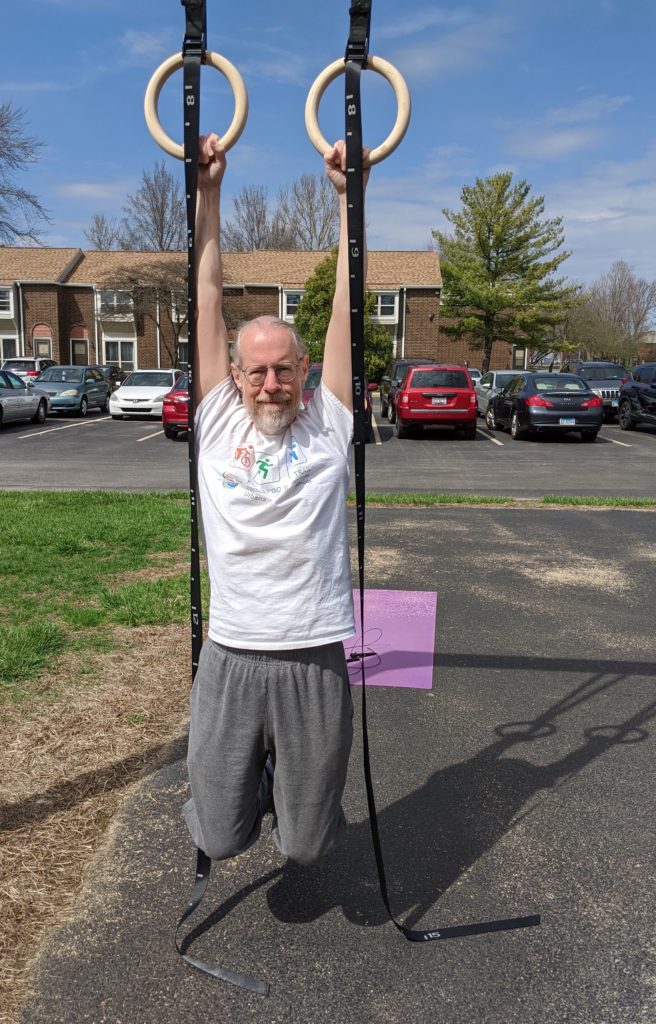
The wall dip is another foundational move for parkour. You use it to get on top of a wall or other structure.
The village where I live seems to have a terrible dearth of chest-high walls (unlike campus, which has lots), so it has been persistently difficult to get in the practice I need, and doubly so during the pandemic.
What I’ve been doing instead this year are ring dips.
Ring dips are actually much harder than wall dips, because the rings are unstable, so you have to stabilize them yourself. As I sat down to write this, I was worried that the limitations of those stabilizing muscles might have kept me from fully training the pushing muscles for the dip itself.
So over the last few days I’ve checked for that, using the edge of my window seat as a wall for practice. (It’s not perfect, because it’s too low, so I have to tuck my legs back to keep my feet off the floor. That configuration doesn’t precisely match the way you’d do a wall dip in parkour, but it does let me fully test the basic pushing motion.)
My original benchmark was:
Success will be when I can do a dozen or so wall dips with good form.
On three different occasions this week I’ve done at least a dozen wall dips, so I can call that one accomplished as well.
Assuming I can keep it together to do at least some maintenance training during the winter, I can enter the spring with a solid base on which to pick up my parkour training!

This is the first decision point on my runs. If it’s going to be a short run, I go right. Today was a long run, so I went left.

Less than a mile further along. I’m always a little surprised by the people who would rather see a blank wall than a wonderful footpath.

About the mid-point of today’s run, my longest of the season.

The immature Bald Eagles I’ve been seeing occasionally the last couple of years are all grown up!

Depending on how far I want to run, I can choose any of several routes through or past Burwash Park. Whichever I take, by the time I get here I’m about 1 mile from home.
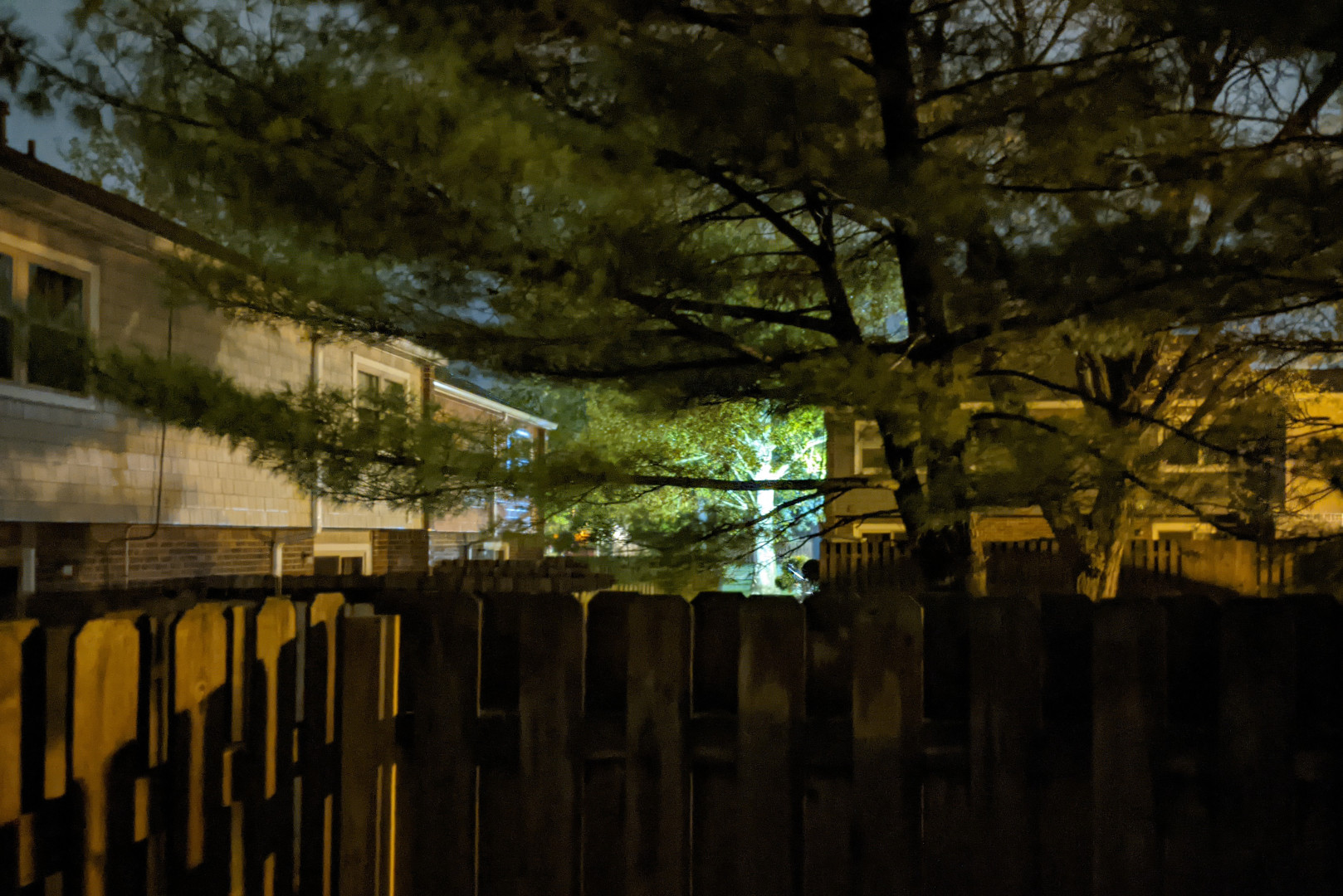 Since I was just talking a few days ago about wanting to name our house (for stationery purposes), this NYT article is timely: A House by Any Other Name.
Since I was just talking a few days ago about wanting to name our house (for stationery purposes), this NYT article is timely: A House by Any Other Name.

Objectively speaking, autumn is probably the best season. Not cold like winter, stormy like spring, or hot like summer, autumn has great weather—totally aside from the pretty colors and Halloween (arguably the best holiday, albeit in a near tie with Groundhog’s Day).
For pretty much my entire adult life I’ve dreaded the cold dark days of winter, and among the many ways that Seasonal Affect Disorder affected my life in a negative way was that it ruined autumn. I could usually get past the summer solstice okay (although in the back of my head, I knew that the best day of the year had come and gone), and I could keep it together through July and August. But by the beginning of September I knew that winter was coming, and I’d spend the last months of nice weather steeling myself against the dark days to come.
It was the dark that bothered me, more than the cold. It’s easy to armor yourself against the cold—flannel, moleskin, fleece, wool, down—there are many ways to deal with cold. But even a Verilux light therapy lamp (which does help) does not solve the problem of the dark days of winter.
All of which is merely an introduction to saying: Last winter I did not suffer from SAD!
I had meant to write something at the time, but I didn’t want to speak too soon, and then once it was spring, it didn’t seem like the most important thing.
I don’t want to jinx anything, and I’m sure the right combination of stressors on top of the cold and dark could once again put me in a bad place, but something more important has changed than just a good year: I’m no longer afraid of the dark days. Maybe I’ll suffer from SAD again, and maybe I won’t, but at least the mere knowledge that the cold and dark is coming is not ruining my fall! In the back of my head I seem to have turned a corner and developed some confidence that I’ll be okay despite the season.
So what has helped?
First, not having to work a regular job. I’m sorry that I can’t recommend something more generally available, but that was the biggest thing that made a difference. Because I don’t have to be productive on a day-to-day basis, I avoid the depression-spiral that used to result from realizing that I wasn’t getting anything done, which made me anxious about losing my job and being unable to support my family, having the anxiety make me more depressed, and the depression making me even less productive. That used to be a killer. On top of that, because I don’t have to be in the office during any particular hours, I’m able to spend a few of the few non-dark hours of the day outdoors, taking advantage of what daylight there is (and making some outdoorphins).
Second, exercise. I always knew it was important, but I took things up a notch each of the last few years, and each new tick up turned out to provide an enormous improvement in my mood. In my experience, all kinds of exercise are good. Endurance exercise is good. High-intensity interval training (HIIT) is good. Skill-based training—ballet, parkour, animal moves, taiji—is good. Resistance exercise (lifting) is perhaps best of all. Letting the dark days of winter compress you down into a lump that seeks (but never finds) cozy because you’re unable to move? That’s the worst.
Third, community. Granted this is not so easy during a pandemic, but even people that you only see on-line are still people you can have a connection with, and having connections is good.
Fourth, something to look forward to. It can be almost anything. Last year I was looking forward to having my family visit. Other years I’ve looked forward to taking a vacation somewhere warm. Even little things help me—ordering some fountain pen ink or cold-weather workout clothes and then looking forward to the package being delivered, and then looking forward to using the newly acquired item.
Fifth, a project that you can make progress on. Ideally something without a deadline—at least, no deadline during the dark days of winter—but a project that you care about. Something that you can spend a few minutes on every day and see some headway that brings you closer to completing it. Creative projects are good, but creativity isn’t as important as just having a thing that you’re working on, and making steady headway.
Not suffering from SAD, even if just for one year, has been wonderful. Having some confidence that things will be okay-enough this winter that I’m not spending all fall dreading it is even more wonderful-er.
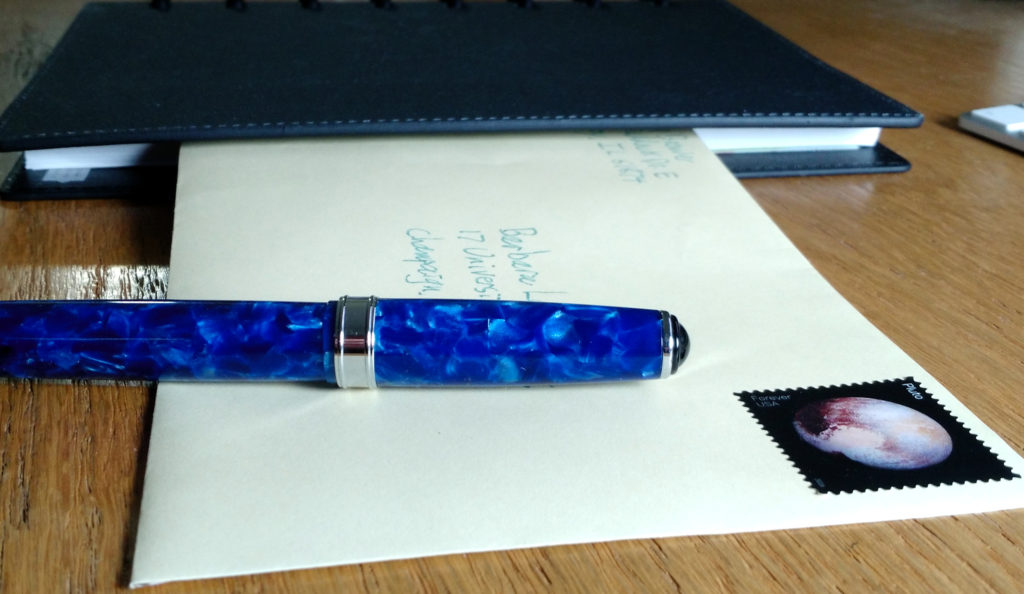 I think we should get some house stationery, but I really think we should name our house.
I think we should get some house stationery, but I really think we should name our house.
“House stationery … may be used by any resident of the house or by any guest during their stay. It’s typically personalized with the name or address of the house…”
Source: Summer Gift Idea: House Stationery – Crane Post Script

Jackie attended the annual Illinois Master Naturalist’s conference last week, and came away with any number of interesting tidbits, but one in particular stuck with me: Forest bathing is like ergonomics.
Both Jackie and I have had our understanding of ergonomics informed by Katy Bowman, who points out:
Modern ergonomics is not the scientific pursuit of what is best for the human body, but the scientific pursuit of how the human body can be positioned (in one position, for eight or more hours at a time) for the purpose of returning to work the next day, and then the next and the next and the next.
Don’t Just Sit There by Katy Bowman; excerpt.
What Jackie learned at her conference was that the Japanese concept of forest bathing (shinrin-yoku) has roots in the same idea. When Japanese salarymen started dying from overwork, a lack of exposure to nature was put forward as a partial explanation.
If the problem is a lack of exposure to nature, then immersing yourself in nature is an obvious solution. But, of course, actually immersing yourself in nature would take too much time out of the workday. Hence the research into forest bathing is all about finding the minimum effective dose. There is little or no research into figuring out the optimum time for humans to spend in nature.
Keep that in mind when you read yet another article about how just looking at a forest scene for 20 minutes reduces salivary cortisol 13.4%, or walking in the woods for just 40 minutes improves mood and boosts feelings of health and robustness.
I’m not so much interested in the answer to the question, “What’s the least number of minutes I can spend in nature and not die early from overwork?”
I’m more interested in questions like:
I have my own tentative answers to many of these questions, but very little data.
